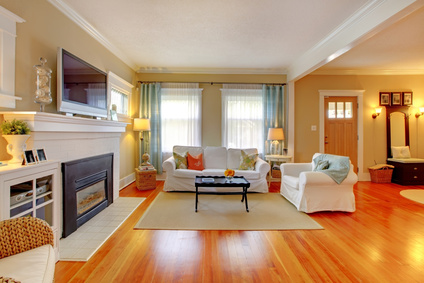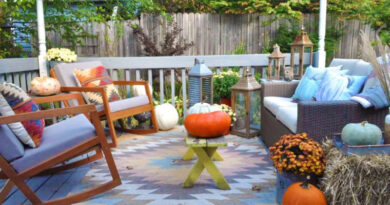How to Refinish Old Hardwood Floors
Wooden floors are a beautiful, natural accent to any style of decor, but years of constant use eventually wears the finish, leaving a dull, worn-out floor. You may have pulled up old, ratty carpeting in the hopes of restoring the hardwood beneath, only to find it in disreputable shape, with traffic wear, water stains, burns, or other damage. You can restore that old wood plank floor to its original beauty by stripping off the surface, sanding down to new wood, and applying a new finish.

Refinishing wood floors yourself can be time-consuming and expensive, but attractive wood floors are an investment that can add value to your home. This is a general method that will work on most old wood floors that have not been already sanded too thin or have major cracks and splits in the wood. When the wood has a lot of damage, it’s time to put down a new floor!
Preparing the Work Area
Refinishing an old wood floor can raise a lot of dust! You’ll want to create a barrier between the room you are working on and the rest of the house. Move everything you can out of the room, and fasten heavy plastic on both sides of any doors that lead into the room to keep dust contained. Use painter’s masking tape to seal off registers, cabinets, and other places where dust can collect. When the weather permits, open a window and use a fan to draw dust outside.
Before you begin sanding the floor, you need to remove all traces of the old finish with mineral spirits or wax remover. Remember to keep the area well-ventilated and to wear protective eyewear, rubber gloves, and a respirator when using these chemicals. Removing the finish before sanding will keep the sandpaper from clogging up with wax and other residue, make the sanding go smoothly, and cut down on your investment in sandpaper.
Getting Down To Bare Wood
Begin with a coarse grit sanding disc, 60 is good to start with. Do two passes in each direction. Change to 80 grit, and then 100, doing two passes in each direction again. Work at an even pace and keep the sander moving, taking care that you don’t stall in one spot and end up with a depression in the floor. When turning the drum sander, lower it carefully to the floor again to prevent gouges.d! Staining a floor requires more intensive sanding, and older floors may be too damaged or thin to withstand the assault.Use the edger to get along the edges of the room, then finish up the corners with the sanding block or palm sander. Check for “chatter” marks that may have been created by the drum sander or edger. Use a fine sandpaper to erase small irregularities.Now that you have the floor sanded (whew) you need to shop vac the floor twice, and use a tack cloth to remove every remaining trace of dust. Use crevice tools to get into the corners and along edges. Not following this step carefully can result in white streaks (from old polish and sawdust) in your newly refinished floor! The walls and ceilings, and whatever else remains in the room, will need wiped down, too.
Choosing a Finish
is the finish most commonly used. It is durable and seals the pores of the wood, protecting the floor against moisture. You have two basic choices in polyurethane sealants: oil-based and water-based. Both have their strengths and weaknesses, and neither is a bad choice. Your expertise and how long you can wait to walk on the floor are two factors in this decision.
Water-based poly dries more quickly, and can be walked on about seven hours after the final coat. However, since it dries so quickly, it’s hard to keep a “wet edge” that won’t leave lap marks where wet poly was applied over partially-dried finish. Three coats of water-based polyurethane are recommended for durability.
Oil-based polyurethane takes considerably longer to dry, about 24 hours, and has noxious fumes. The advantage for beginners is that the long drying time gives you a chance to correct mistakes, and you can get by with two coats for durability. Most refinishing experts consider oil-based polyurethane better at resisting scratches and chips, a major consideration if you have kids and pets running about!
Water-based polyurethane does have the advantage of remaining clear, while oil-based will develop an amber color over time. For light-colored floors, you will probably want to use the water-soluble variety. Darker floors can handle the oil-based poly without noticeable discoloration. Choose a satin-finish or semi-gloss polyurethane to give your floor a soft, warm glow.
You can also use varnish as a finish. It is less durable but acceptable for homes without a lot of traffic.
Finishing Pointers
Choose refinishing products that are compatible with the type of wood you have. If you aren’t sure what to use, ask an expert what they recommend. Follow manufacturer’s instructions exactly as they are printed on the containers!
Many refinishing products contain noxious chemicals that can be dangerous if not used with adequate ventilation. Always wear protective clothing, rubber gloves, goggles, and a respirator when working in a confined space that is full of dust and chemical fumes. Keep a window open, if possible, with a fan to draw the dust and fumes out of the house.
Prevent future scratches and wear by regularly sweeping and dry mopping the floor. Put mats by entrances from outside to catch dirt and grime, and use area rugs in high traffic areas.
While refinishing an old wood floor yourself is a huge effort, it can be rewarding when family and friends admire your loving handiwork. You may be happier with the results you have than those of a professional floor refinisher who just wants to hurry and get the job done.



